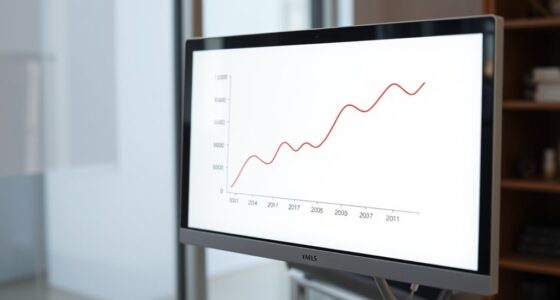Understanding mean, median, and mode helps you interpret data more accurately. The mean is your average, adding all values and dividing by the count, but it can be affected by outliers. The median finds the middle value, useful for skewed data or when outliers exist. The mode shows the most common value, highlighting trends in data. Exploring these measures in detail can give you a clearer picture of data’s key characteristics.
Key Takeaways
- Mean is the average of data points, calculated by dividing the sum of values by the number of observations.
- Median is the middle value when data is ordered; useful in skewed distributions or with outliers.
- Mode is the most frequently occurring value, highlighting the most common data point or category.
- The mean is sensitive to outliers, while median and mode provide more robust measures in skewed data.
- Understanding all three helps select the appropriate measure of central tendency for accurate data interpretation.

When analyzing data, understanding the concepts of mean, median, and mode is essential because they help you summarize and interpret information effectively. These measures of central tendency provide a clear picture of your data set, making it easier to grasp overall trends and patterns. In statistical analysis, choosing the right measure depends on the nature of your data and what you want to highlight. They each serve a specific purpose and can reveal different insights about your data distribution.
Understanding mean, median, and mode helps you interpret data patterns effectively.
The mean is the most common measure, calculated by adding all the values together and dividing by the number of observations. It offers a straightforward average that reflects the overall level of your data. For example, if you’re analyzing test scores, the mean score indicates how students, on average, performed. However, the mean can be sensitive to outliers—extremely high or low values—that skew the average and may not accurately represent the typical data point. This is where understanding data interpretation becomes vital, as you need to determine whether the mean provides a fair summary of your data or if outliers are distorting it.
The median is the middle value when your data is ordered from smallest to largest. If there’s an odd number of data points, the median is the one right in the middle; if even, it’s the average of the two middle values. The median is particularly useful in skewed distributions, where extreme values pull the mean away from the center. For instance, in income data, where a few very high incomes can inflate the mean, the median gives a more accurate sense of what a typical individual earns. Understanding when to use the median improves your data interpretation, especially in cases where outliers or skewed data are involved.
Mode is the value that appears most frequently in your data set. It can be useful for identifying the most common category or value, especially in categorical data. For example, if you’re analyzing favorite colors among a group, the mode reveals the most popular choice. Unlike the mean or median, the mode does not necessarily provide a sense of the data’s central point but highlights the most typical or frequent occurrence. In some data sets, there can be multiple modes, indicating a bimodal or multimodal distribution, which can be an important insight during statistical analysis. Additionally, understanding the role of quality assurance in data collection and analysis can help ensure the accuracy of these measures.
Frequently Asked Questions
How Do Measures of Central Tendency Differ in Skewed Distributions?
In skewed distributions, the measures of central tendency differ because skewness impacts their values. The mean gets pulled toward the tail, making it less representative of the typical data point. The median remains more resistant to skewness, staying closer to the center of the distribution. The mode indicates the most frequent value, which may not shift much with skewness. Understanding distribution symmetry helps you interpret these differences accurately.
Can Mean, Median, and Mode Be the Same in All Data Sets?
You might think the mean, median, and mode are always the same, but that’s a rare cosmic phenomenon! Usually, data consistency varies, so these measures often differ. They can all be equal in perfectly symmetrical, uniform datasets, but that’s uncommon. Comparing these measures helps you understand data distribution better. So, while possible, it’s a special case, not a typical scenario in most data sets.
Which Measure Is Best for Categorical Data Analysis?
For categorical data analysis, the mode is your best choice because it identifies the most frequently occurring category, making it ideal for nominal data analysis. Unlike mean and median, which are suited for numerical data, the mode helps you understand which category dominates. Categorical data measures focus on frequency, so relying on the mode provides clear insights into the most common categories in your dataset.
How Do Outliers Affect the Mean and Median?
Did you know that outliers can skew the mean by pulling it toward extreme values? Outlier impact on the mean is significant, often making it less representative of the typical data point. However, the median remains stable because it focuses on the middle value, unaffected by outliers. So, if your data has outliers, rely on the median for a more accurate measure of central tendency.
When Should I Use Mode Over Mean or Median?
You should use the mode when you need a measure for data with a high frequency comparison, like most common categories or items. Choose the mode for nominal data, where data types don’t have a natural order, or when identifying the most frequent value matters most. It’s especially useful in market research, surveys, or any situation where identifying the most typical category provides valuable insights.
Conclusion
So, now that you understand mean, median, and mode, you can better analyze data and draw meaningful insights. These measures help you see the story behind numbers and make informed decisions. Remember, which measure you choose depends on your data and what you want to highlight. Isn’t it powerful to know how to find the center of a dataset? Use these tools wisely, and you’ll become more confident in interpreting any data you encounter.










